Page 16 of 626
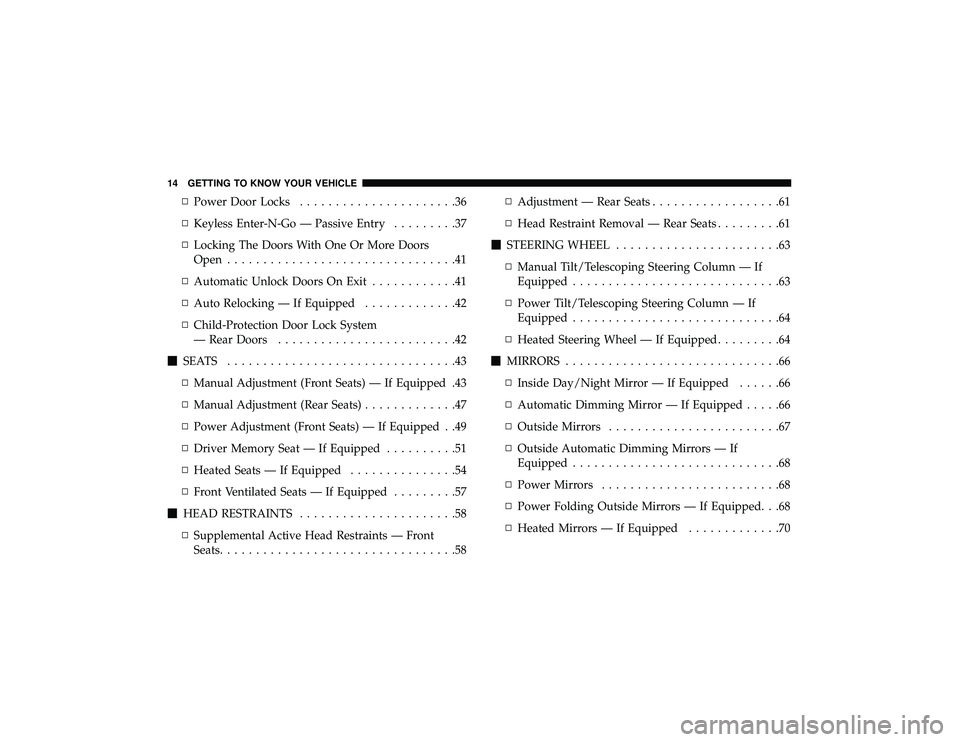
▫Power Door Locks ......................36
▫ Keyless Enter-N-Go — Passive Entry .........37
▫ Locking The Doors With One Or More Doors
Open ................................41
▫ Automatic Unlock Doors On Exit ............41
▫ Auto Relocking — If Equipped .............42
▫ Child-Protection Door Lock System
— Rear Doors .........................42
� SEATS ................................43
▫ Manual Adjustment (Front Seats) — If Equipped .43
▫ Manual Adjustment (Rear Seats) .............47
▫ Power Adjustment (Front Seats) — If Equipped . .49
▫ Driver Memory Seat — If Equipped ..........51
▫ Heated Seats — If Equipped ...............54
▫ Front Ventilated Seats — If Equipped .........57
� HEAD RESTRAINTS ......................58
▫ Supplemental Active Head Restraints — Front
Seats .................................58 ▫
Adjustment — Rear Seats ..................61
▫ Head Restraint Removal — Rear Seats .........61
� STEERING WHEEL .......................63
▫ Manual Tilt/Telescoping Steering Column — If
Equipped .............................63
▫ Power Tilt/Telescoping Steering Column — If
Equipped .............................64
▫ Heated Steering Wheel — If Equipped .........64
� MIRRORS ..............................66
▫ Inside Day/Night Mirror — If Equipped ......66
▫ Automatic Dimming Mirror — If Equipped .....66
▫ Outside Mirrors ........................67
▫ Outside Automatic Dimming Mirrors — If
Equipped .............................68
▫ Power Mirrors .........................68
▫ Power Folding Outside Mirrors — If Equipped. . .68
▫ Heated Mirrors — If Equipped .............70
14 GETTING TO KNOW YOUR VEHICLE
Page 29 of 626
WARNING!(Continued)
•Do not leave children or animals inside parked
vehicles in hot weather. Interior heat build-up may
cause serious injury or death.
CAUTION!
An unlocked vehicle is an invitation for thieves. Al-
ways remove key fob from the vehicle and lock all
doors when leaving the vehicle unattended.
NOTE: Refer to �Starting The Engine,� in�Starting And
Operating� for further information.
Vehicle On Message
When opening the driver’s door when the ignition is in
RUN (engine not running), a chime will sound to remind
you to place the ignition in the OFF position. In addition to
the chime, the message will display “Ignition Or Accessory
On” in the cluster. NOTE:
The power window switches and power sunroof (if
equipped) will remain active up to ten minutes after the
ignition is cycled to the OFF position. Opening either front
door will cancel this feature. The time for this feature is
programmable.
Page 30 of 626
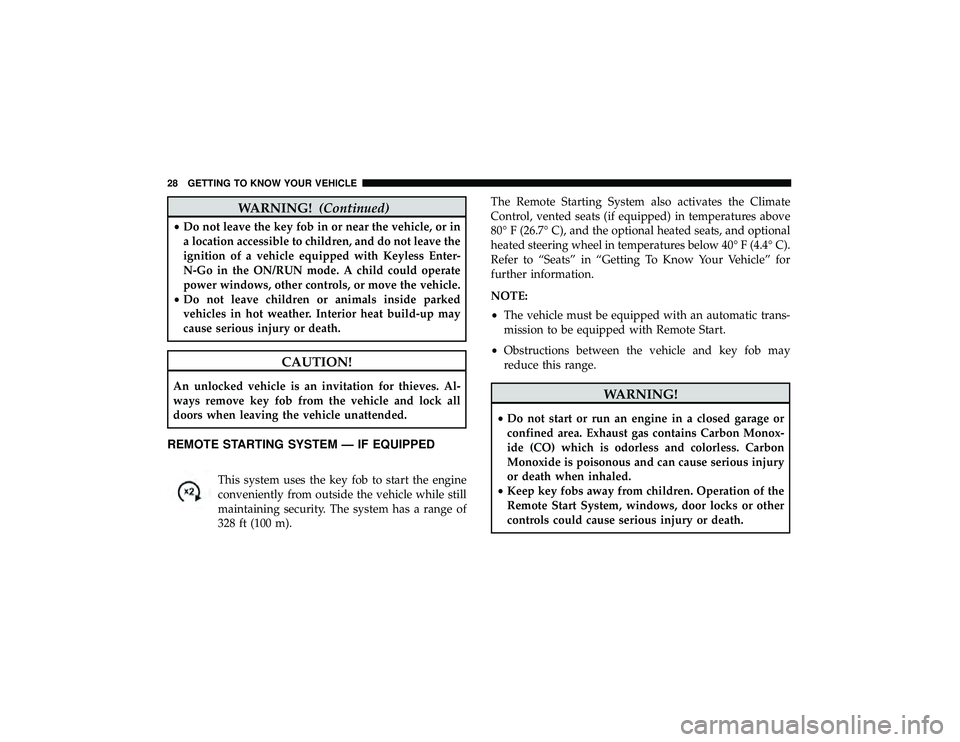
WARNING!(Continued)
•Do not leave the key fob in or near the vehicle, or in
a location accessible to children, and do not leave the
ignition of a vehicle equipped with Keyless Enter-
N-Go in the ON/RUN mode. A child could operate
power windows, other controls, or move the vehicle.
• Do not leave children or animals inside parked
vehicles in hot weather. Interior heat build-up may
cause serious injury or death.
CAUTION!
An unlocked vehicle is an invitation for thieves. Al-
ways remove key fob from the vehicle and lock all
doors when leaving the vehicle unattended.
REMOTE STARTING SYSTEM — IF EQUIPPED
This system uses the key fob to start the engine
conveniently from outside the vehicle while still
maintaining security. The system has a range of
328 ft (100 m). The Remote Starting System also activates the Climate
Control, vented seats (if equipped) in temperatures above
80° F (26.7° C), and the optional heated seats, and optional
heated steering wheel in temperatures below 40° F (4.4° C).
Refer to “Seats” in “Getting To Know Your Vehicle” for
further information.
NOTE:
•
The vehicle must be equipped with an automatic trans-
mission to be equipped with Remote Start.
• Obstructions between the vehicle and key fob may
reduce this range.
Page 38 of 626
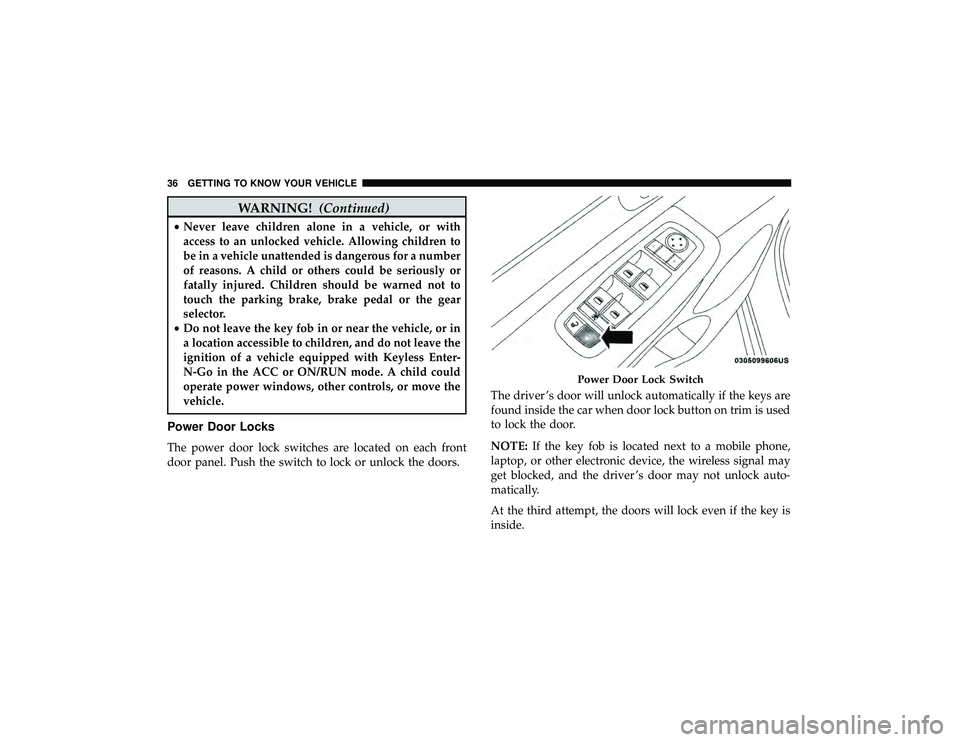
WARNING!(Continued)
•Never leave children alone in a vehicle, or with
access to an unlocked vehicle. Allowing children to
be in a vehicle unattended is dangerous for a number
of reasons. A child or others could be seriously or
fatally injured. Children should be warned not to
touch the parking brake, brake pedal or the gear
selector.
• Do not leave the key fob in or near the vehicle, or in
a location accessible to children, and do not leave the
ignition of a vehicle equipped with Keyless Enter-
N-Go in the ACC or ON/RUN mode. A child could
operate power windows, other controls, or move the
vehicle.
Power Door Locks
The power door lock switches are located on each front
door panel. Push the switch to lock or unlock the doors. The driver ’s door will unlock automatically if the keys are
found inside the car when door lock button on trim is used
to lock the door.
NOTE:
If the key fob is located next to a mobile phone,
laptop, or other electronic device, the wireless signal may
get blocked, and the driver ’s door may not unlock auto-
matically.
At the third attempt, the doors will lock even if the key is
inside.
Page 44 of 626
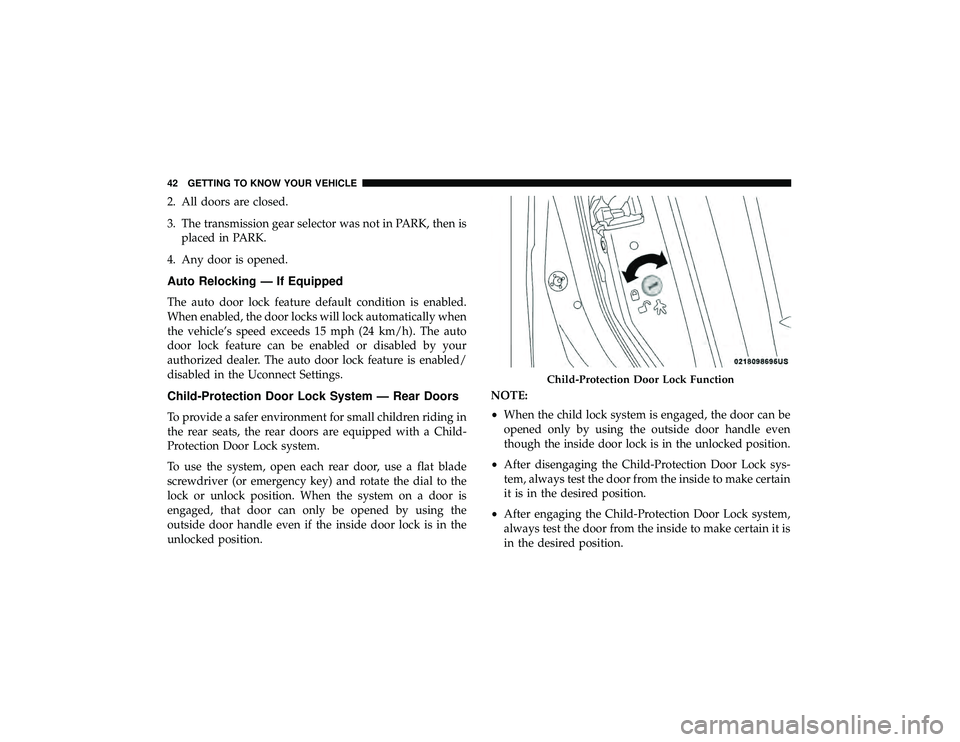
2. All doors are closed.
3. The transmission gear selector was not in PARK, then isplaced in PARK.
4. Any door is opened.
Auto Relocking — If Equipped
The auto door lock feature default condition is enabled.
When enabled, the door locks will lock automatically when
the vehicle’s speed exceeds 15 mph (24 km/h). The auto
door lock feature can be enabled or disabled by your
authorized dealer. The auto door lock feature is enabled/
disabled in the Uconnect Settings.
Child-Protection Door Lock System — Rear Doors
To provide a safer environment for small children riding in
the rear seats, the rear doors are equipped with a Child-
Protection Door Lock system.
To use the system, open each rear door, use a flat blade
screwdriver (or emergency key) and rotate the dial to the
lock or unlock position. When the system on a door is
engaged, that door can only be opened by using the
outside door handle even if the inside door lock is in the
unlocked position. NOTE:
•
When the child lock system is engaged, the door can be
opened only by using the outside door handle even
though the inside door lock is in the unlocked position.
• After disengaging the Child-Protection Door Lock sys-
tem, always test the door from the inside to make certain
it is in the desired position.
• After engaging the Child-Protection Door Lock system,
always test the door from the inside to make certain it is
in the desired position.
Page 51 of 626
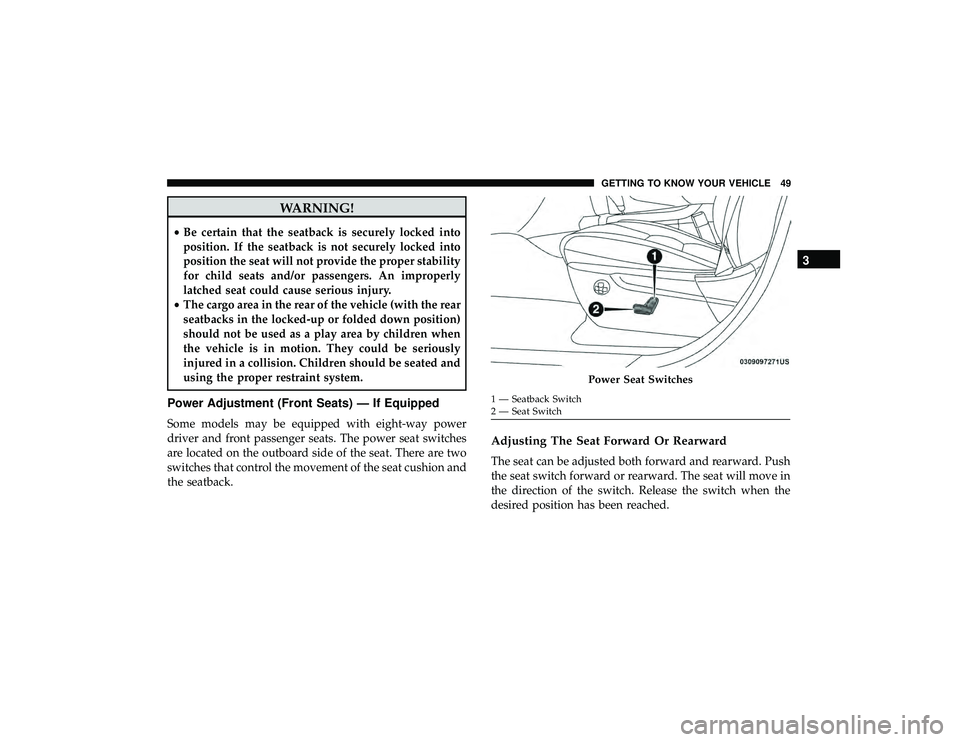
WARNING!
•Be certain that the seatback is securely locked into
position. If the seatback is not securely locked into
position the seat will not provide the proper stability
for child seats and/or passengers. An improperly
latched seat could cause serious injury.
• The cargo area in the rear of the vehicle (with the rear
seatbacks in the locked-up or folded down position)
should not be used as a play area by children when
the vehicle is in motion. They could be seriously
injured in a collision. Children should be seated and
using the proper restraint system.
Power Adjustment (Front Seats) — If Equipped
Some models may be equipped with eight-way power
driver and front passenger seats. The power seat switches
are located on the outboard side of the seat. There are two
switches that control the movement of the seat cushion and
the seatback.
Adjusting The Seat Forward Or Rearward
The seat can be adjusted both forward and rearward. Push
the seat switch forward or rearward. The seat will move in
the direction of the switch. Release the switch when the
desired position has been reached.
Page 63 of 626
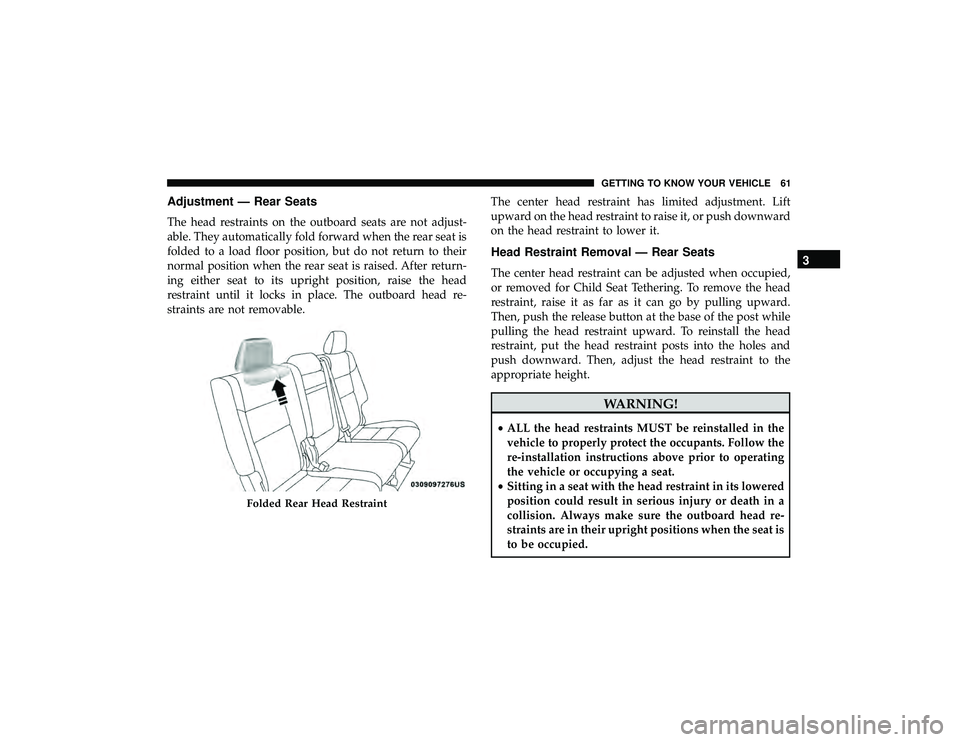
Adjustment — Rear Seats
The head restraints on the outboard seats are not adjust-
able. They automatically fold forward when the rear seat is
folded to a load floor position, but do not return to their
normal position when the rear seat is raised. After return-
ing either seat to its upright position, raise the head
restraint until it locks in place. The outboard head re-
straints are not removable.The center head restraint has limited adjustment. Lift
upward on the head restraint to raise it, or push downward
on the head restraint to lower it.
Head Restraint Removal — Rear Seats
The center head restraint can be adjusted when occupied,
or removed for Child Seat Tethering. To remove the head
restraint, raise it as far as it can go by pulling upward.
Then, push the release button at the base of the post while
pulling the head restraint upward. To reinstall the head
restraint, put the head restraint posts into the holes and
push downward. Then, adjust the head restraint to the
appropriate height.
Folded Rear Head Restraint
3
GETTING TO KNOW YOUR VEHICLE 61
Page 210 of 626
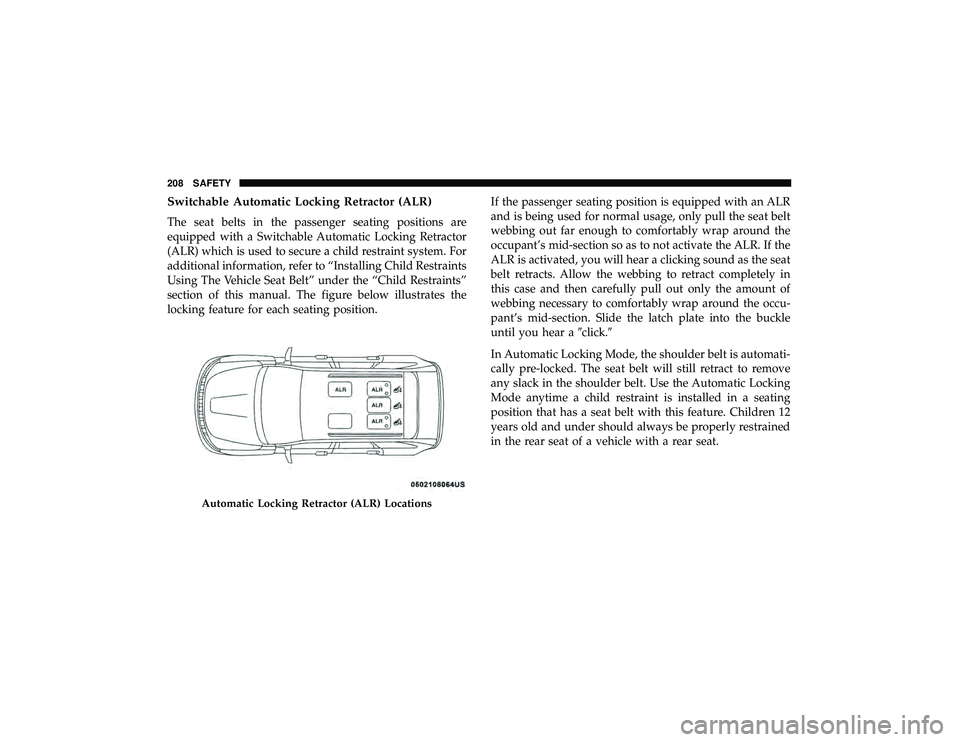
Switchable Automatic Locking Retractor (ALR)
The seat belts in the passenger seating positions are
equipped with a Switchable Automatic Locking Retractor
(ALR) which is used to secure a child restraint system. For
additional information, refer to “Installing Child Restraints
Using The Vehicle Seat Belt” under the “Child Restraints”
section of this manual. The figure below illustrates the
locking feature for each seating position.If the passenger seating position is equipped with an ALR
and is being used for normal usage, only pull the seat belt
webbing out far enough to comfortably wrap around the
occupant’s mid-section so as to not activate the ALR. If the
ALR is activated, you will hear a clicking sound as the seat
belt retracts. Allow the webbing to retract completely in
this case and then carefully pull out only the amount of
webbing necessary to comfortably wrap around the occu-
pant’s mid-section. Slide the latch plate into the buckle
until you hear a
�click.�
In Automatic Locking Mode, the shoulder belt is automati-
cally pre-locked. The seat belt will still retract to remove
any slack in the shoulder belt. Use the Automatic Locking
Mode anytime a child restraint is installed in a seating
position that has a seat belt with this feature. Children 12
years old and under should always be properly restrained
in the rear seat of a vehicle with a rear seat.